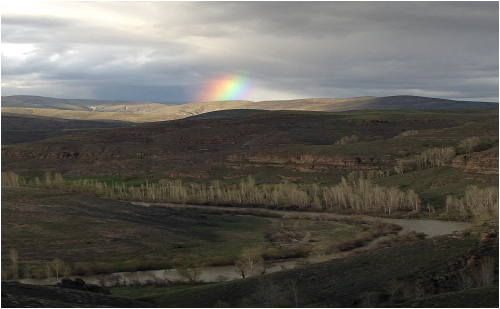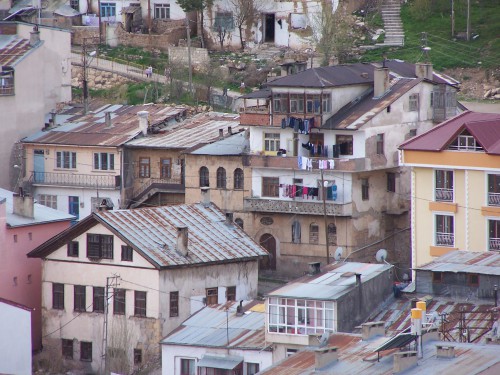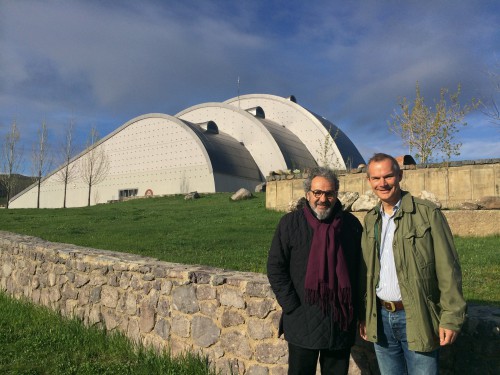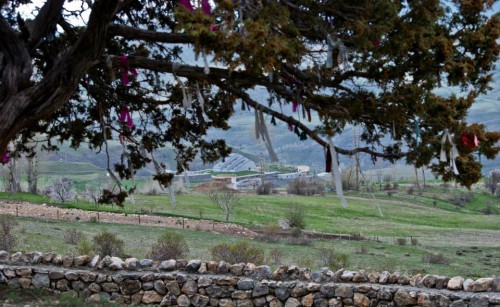19th June 2015
Crossroads and boundaries: Eastern Anatolia
 Snow-capped peaks tower over ancient mausoleums. Although they were built by Saltukids in the 12th Century, the steep-roofed tombs are reminiscent of Armenian churches. The nearby Selcuk-era madrasah features both Central Asian-style twin minarets and double-headed Byzantine eagles. Above the city, in a fortress founded by Emperor Theodosius in the 4th century, a newer minaret-like structure has a bell tower at the top.
Snow-capped peaks tower over ancient mausoleums. Although they were built by Saltukids in the 12th Century, the steep-roofed tombs are reminiscent of Armenian churches. The nearby Selcuk-era madrasah features both Central Asian-style twin minarets and double-headed Byzantine eagles. Above the city, in a fortress founded by Emperor Theodosius in the 4th century, a newer minaret-like structure has a bell tower at the top.
At the crossroads of Europe and Asia, Turkey is rich with ancient cultures. In Eastern Anatolia, the memories run deep. Caucasian pottery from 2000 BC stands next to Urartian stone texts from 1000 BC. Architecture, relics and traditions echo Christianity, Islam and even shamanism. Persians, Romans, Umayyads, Byzantines, Georgians, Armenians, Seljuks, Mongols, Russians, and Ottoman Turks have left their mark. Ghosts people a stark landscape poised between past, present and future.
I visit Eastern Anatolia in May, flying over mountains thick with snow. We take the new dual carriageway from Erzurum through the Otlukbeli Mountains. From the site of the new Mount Kop Tunnel the old road winds to the 2,400m Kop Pass. Here, a monument marks battles between Russia and Ottoman Turkey.
Soon, the tunnel will slash journey times and keep the road, often snow-bound, open all year. Sadly it will also mean most travellers miss the monument, and the ancient pass at which it stands.
Bayburt castle was destroyed by the Russians and is much restored. From here, you can glimpse Bayburt’s remaining traditional stone buildings, nestling in less-developed areas of the city.
The nearby Aydintepe underground city is enigmatic: no-one is sure who built it; when; or why. But the tunnels and side-chambers offer a glimpse of how its mysterious inhabitants might have eked out their troglodytic existence.
Husamettin Koçan spent his childhood sitting on a hill outside the tiny village of Baksi – an hour’s drive into the mountains east of Bayburt – waiting for his Gastarbeiter father to return from Germany. Years later, watching the depopulation of the region, he vowed to do his bit to reverse that trend by setting up a fine arts museum on that same hill.
The need is real. By a river below the site, a farmer cutting strips of poplar tells me life is tough. The season is short. It is hard to compete with more favoured areas. People, he says, want to emigrate to the cities to earn more money.
The Baksi museum opened in 2010. Its architecture, inspired by nearby villages, is graceful amidst the mountain landscape. The citation for its award of the 2014 Council of Europe Museum Prize describes it as: “A stimulating example of how to bridge the gap between centre and periphery”.
I enjoy the art in the museum, including Candeger Furtun’s “Clapping”; “Femur” by Erdal Duman; and Koçan’s own “To stay or to go”. Women from the village come for weaving workshops, filling the museum shop with must-have fabrics.
Koçan lives on-site. An avuncular, modest figure, he tells me the museum brings him joy. Nothing is easy: he points to a blue metal sculpture, damaged when the wind blew it over. ‘Sculptures have lives too,’ he says. ‘I cry, the statue is bent.’
In this ethereal place it is easy to sense the entrenched traditions of this crossroads region. Above Baksi, a wall surrounds a bent juniper, its branches thick with fabric strips. This is a “wish tree”, associated with shamanistic traditions. Tourists tie ribbons, take selfies and videos and, perhaps, make some wishes.
It is good to see traditions surviving. ‘Modernity is killing identity,’ says Koçan, ‘especially in the cities. It is always hard to leave here to go back to Istanbul.’
Back on the bus, our guide says the tree reminds her of the “tree of souls” in James Cameron’s movie “Avatar”. She tells the story of the Native American who, taking a settler through a wood, urged them to slow down in case their spirits were left behind.
Erzurum is packed with archaeology and iconic symbols of Turkey’s republican history. Ataturk held his historic 1919 congress here: you can visit the house where he stayed and soak up the atmosphere of the foundation of the Turkish Republic. The Ulu Cami is a stunning series of arched spaces from 1176.
Although the cities may be the shop-window of modern Anatolia, it is the countryside that most evokes the timelessness of this remote region. ‘The white, grey, green and brown creep up the mountains in the spring and summer,’ Koçan says. ‘In the winter, they descend into the valleys.’
Back at the wish tree, the tourists drift back towards their bus. Two shepherd-boys arrive, tending a herd of hardy cows. The boys enter the compound of the tree and settle down in its shade, smiling and chatting, to supervise their charges. One pulls out an iPad and they listen to Beyonce as the cows harvest the mountain meadow.


